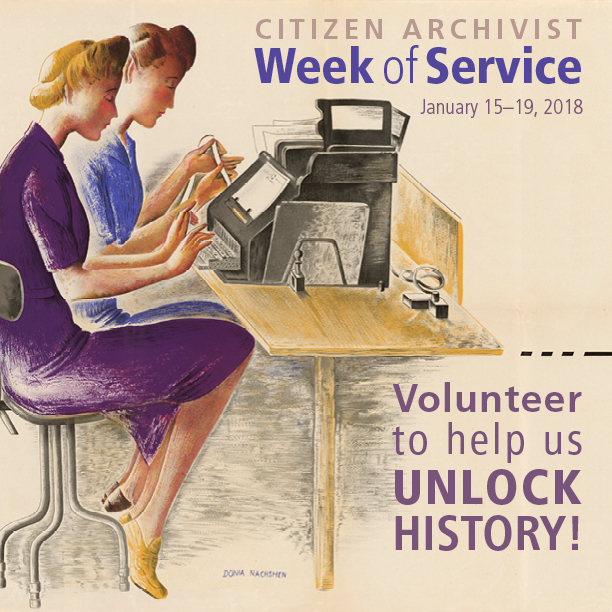
Citizen Archivists Tag Records
By Kerri Lawrence | National Archives News
 WASHINGTON, January 19, 2018 — The National Archives held a Citizen Archivist Week of Service this week in honor of the Dr. Martin Luther King, Jr. Day of Service. The goal was to have citizens “tag” and transcribe primary source documents—2,018 pages to be exact—in the National Archives Catalog. Words that are added become part of the Catalog, improving search results, making records more discoverable, and unlocking the sometimes difficult to read text for all to understand.
WASHINGTON, January 19, 2018 — The National Archives held a Citizen Archivist Week of Service this week in honor of the Dr. Martin Luther King, Jr. Day of Service. The goal was to have citizens “tag” and transcribe primary source documents—2,018 pages to be exact—in the National Archives Catalog. Words that are added become part of the Catalog, improving search results, making records more discoverable, and unlocking the sometimes difficult to read text for all to understand.
As the week-long event came to a close, 430 citizen archivists helped tag and transcribe more than 3,500 pages—surpassing the original goal.
The notion of a citizen archivist is not new; It’s a concept the National Archives initiated back in April 2010. Archivist of the United States David S. Ferriero introduced the idea as a way to engage the public with the mission of the National Archives as part of the Open Government Directive of transparency, participation, and collaboration.
“We recognized the value of what researchers learn from our records and how that could be captured and harnessed,” Ferriero said in his AOTUS blog post in April 2010. “We set out a vision to develop digital tools that would make adding real value to our work intriguing, easy, and fun.”
At the National Archives, there is no shortage of paper records that need to be digitized and transcribed. The sheer volume of records creates a huge challenge. Through the collaborative power of the Internet, however, the agency has found a way to digitized more records and engage the American public to whom they belong. With all that info available online, more records are now accessible than ever before.
“All of my years in libraries convinces me that we learn so much more about our collections when someone makes use of the materials and helps us better understand and then describe what we have,” Ferriero said.
Anyone can tag. The concept of tagging was born as a way for online users to apply meaningful keywords or labels to records and make content more discoverable. As items and descriptions are tagged in the National Archives Online Catalog, other users can more quickly and easily find the information they seek.
The Week of Service featured several missions including records relating to civil rights issues in United States history; slave manifests from the Port of New York; records on the White House renovation during the Truman administration; records related to Mediterranean passports to ensure safe passage in areas threatened by Barbary pirates; and records related to marriage licenses from the Office of Indian Affairs White Earth Agency.
In a NARAtions blog post dated January 18, 2018, National Archives Chief Innovation Officer Pamela Wright said, “Citizen Archivists have...found value in engaging online with the records in a way that would not ordinarily be possible. They may not be able to visit a research room to handle the documents, or to pursue a career as an archivist, but they are empowered to participate in and contribute to the mission of the National Archives.”
For interested volunteers, find instructions on how to get started by visiting the Citizen Archivist Dashboard. Visit the Resources page to learn How to Register and Get Started, How to Tag and Transcribe Records, What Makes a Good Tag, and Transcription Tips. The History Hub is another resource to talk to other transcribers, ask questions, and get support for your work as a citizen archivist.
The next scheduled event will be “Sunshine Week” from March 11-17, 2018. However, missions are available at any time on the Citizen Archivist Dashboard and users can also contribute to any record they find in the Catalog, whether in a mission or not.